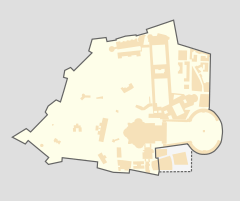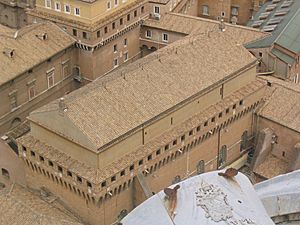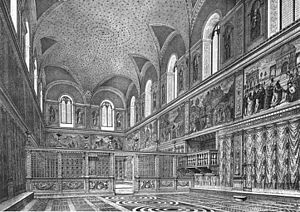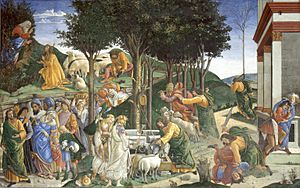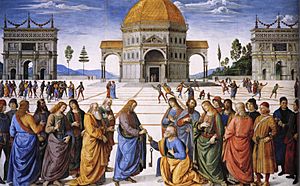Sistine Chapel facts for kids
Quick facts for kids
|
|
|---|---|

East side of the Chapel, from the altar end
|
|
| Religion | |
| Affiliation | Roman Catholic |
| District | Diocese of Rome |
| Ecclesiastical or organizational status | Papal oratory |
| Leadership | Francis |
| Year consecrated | 15 August 1483 |
| Location | |
| Location | Vatican City |
| Architecture | |
| Architect(s) | Baccio Pontelli, Giovanni de Dolci |
| Architectural type | Church |
| Groundbreaking | 1505 |
| Completed | 1508 |
| Specifications | |
| Length | 40.9 metres (134 ft) |
| Width (nave) | 13.4 metres (44 ft) |
| Height (max) | 20.7 metres (68 ft) |
| Official name: Vatican City | |
| Type | Cultural |
| Criteria | i, ii, iv, vi |
| Designated | 1984 |
| Reference no. | 286 |
| State Party | |
| Region | Europe and North America |
The Sistine Chapel is a famous chapel in the Apostolic Palace in Vatican City. This palace is the official home of the Pope. The chapel was built between 1473 and 1481 by Pope Sixtus IV, which is why it's named after him.
For centuries, the Sistine Chapel has been used for important religious events and meetings for the Pope. Today, it is most famous as the place where a new Pope is chosen during a special meeting called a papal conclave.
The chapel is also incredibly famous for its amazing fresco paintings. The most well-known are the Sistine Chapel ceiling and The Last Judgment, both painted by the famous artist Michelangelo.
Before Michelangelo, other great Renaissance painters like Sandro Botticelli and Pietro Perugino decorated the chapel. They painted scenes from the Life of Moses and the Life of Christ on the walls. These paintings were finished in 1482. On August 15, 1483, Pope Sixtus IV held the first mass in the chapel, dedicating it to the Virgin Mary.
Michelangelo painted the chapel's ceiling between 1508 and 1512. This project was a huge artistic achievement and changed art forever. Later, from 1535 to 1541, he returned to paint The Last Judgment on the wall behind the altar. Millions of visitors have come to see Michelangelo's incredible paintings since they were first shown.
Contents
History of the Chapel
The Sistine Chapel is best known for hosting the papal conclaves, where cardinals elect a new Pope. But its main job is to be the chapel for the Pope's official household, called the Papal Chapel. In the late 1400s, this group had about 200 people, including religious leaders and Vatican officials.
The Papal Calendar listed 50 times a year when the whole Papal Chapel would meet. Most of these were masses. Some big masses, like on Christmas and Easter, were held in larger churches like St. Peter's Basilica. But 27 smaller masses could be held in a more private space. Before the Sistine Chapel was built, an older chapel called the Cappella Maggiore was used for these.
The Cappella Maggiore means "Greater Chapel." It was called this because there was another smaller chapel the Pope used daily. Records show the Cappella Maggiore existed in 1368. By the time it was torn down to build the Sistine Chapel, its walls were leaning and it was in bad shape.
The current Sistine Chapel was designed by Baccio Pontelli for Pope Sixtus IV. It was built between 1473 and 1481. The new chapel has similar sizes and shapes to the old one. After it was finished, famous artists like Sandro Botticelli, Domenico Ghirlandaio, Pietro Perugino, and Michelangelo decorated it with beautiful frescoes.
The first mass in the Sistine Chapel was held on August 15, 1483. This was on the Feast of the Assumption, and the chapel was officially dedicated to the Virgin Mary.
The Sistine Chapel is still used today for important papal events. It also has its own choir, the Sistine Chapel Choir, which is famous for its music, including Gregorio Allegri's Miserere.
Choosing a New Pope
One of the most important jobs of the Sistine Chapel is to be the place where cardinals meet to elect a new Pope. This meeting is called a conclave.
During a conclave, a special chimney is put on the chapel's roof. Smoke from this chimney tells the world what is happening. If white smoke appears, it means a new Pope has been chosen! This smoke is made by burning the ballots. If black smoke comes out, it means the cardinals haven't chosen a Pope yet. This smoke is made by burning ballots with wet straw and other things.
The first papal conclave in the Sistine Chapel was in 1492. In that meeting, Pope Alexander VI was elected.
The chapel also provides a space for the cardinals to pray, eat, and sleep during the conclave. Since 1996, cardinals stay in a nearby building called the Domus Sanctae Marthae, but they still vote inside the Sistine Chapel.
In the past, each cardinal had a canopy over their seat during the conclave. This showed that they were all equal. When a new Pope was chosen, the other cardinals would lower their canopies. Later, these canopies were removed because there were too many cardinals, and the canopies blocked the view for those in the back.
To protect the chapel's marble floor during a conclave, workers install a slightly raised wooden floor. They also add a wooden ramp for cardinals who need wheelchairs.
Chapel Design
Building Structure
The chapel is about 35 meters (118 feet) long and 14 meters (46 feet) wide. The ceiling rises about 20 meters (66 feet) above the main floor.
The outside of the chapel looks very plain. It doesn't have fancy decorations or grand entrance doors. This is common for many old Italian churches. You can only see the outside from nearby windows in the Papal Palace. Over time, other buildings have been added around it, changing how the chapel looks from the outside.
The building has three levels. The lowest level is a tall basement with windows and a door to the outside. Inside, this basement has strong arches to support the chapel above. The chapel itself has six tall arched windows on each side and two at each end. Some of these windows have been closed up. Above the main chapel is a third level with rooms for guards. There used to be an open walkway around the outside of this level, but it was covered because water kept leaking into the chapel.
Inside the Sistine Chapel
The chapel's size follows specific rules: its length is three times its width, and its height is half its length. This kind of careful planning was important in Renaissance architecture.
The ceiling of the chapel is shaped like a flattened arch. It was originally painted bright blue with gold stars. The floor is made of marble and colored stone in a decorative pattern. This pattern also shows the path the Pope takes during important ceremonies.
A marble screen divides the chapel into two parts. This screen was made by artists like Mino da Fiesole. It used to divide the space equally between the Pope's group and the public. But as more people came to see the Pope, the screen was moved to give the public less space. The screen has fancy candle holders on top and a wooden door.
Art and Decorations
Art History
The first decoration of the Sistine Chapel was a blue ceiling with gold stars. This was completely changed when Michelangelo started painting the ceiling in 1508.
The oldest paintings on the walls are divided into three main sections. The middle section has two series of paintings: The Life of Moses and The Life of Christ. Pope Sixtus IV asked artists like Domenico Ghirlandaio, Sandro Botticelli, Pietro Perugino, and Cosimo Rosselli to paint these in 1480. These paintings originally went all around the walls, but some were later replaced.
Below these paintings, the lower part of the walls is decorated with painted hangings that look like silver and gold fabric. Above the main paintings, the upper part of the walls has a "Gallery of Popes." Around the arched tops of the windows are areas called lunettes, which Michelangelo painted with the Ancestors of Christ as part of his ceiling project.
The famous ceiling was painted by Michelangelo between 1508 and 1512. He was first asked to paint only twelve apostles. But Michelangelo wanted to paint what he thought was best. So, he painted nine scenes from the Book of Genesis, showing God's Creation of the World, God's Relationship with Mankind, and Mankind's Fall from God's Grace. On the larger curved sections, he painted twelve prophets and figures who foretold the coming of Jesus.
In 1515, Pope Leo X asked Raphael to design ten tapestries to hang on the lower walls. These tapestries showed events from the lives of Saint Peter and Saint Paul. They were made in Brussels and took four years to finish. The tapestries were stolen in 1527 during a war and spread across Europe. In the late 1900s, a set was put back together and displayed in the chapel again in 1983. These tapestries are still used for very important ceremonies.
Later, Michelangelo was asked to paint The Last Judgment on the wall behind the altar, from 1537 to 1541. To do this, some of the earlier paintings on that wall had to be covered up.
Famous Frescoes
Southern Wall Paintings
The southern wall shows the Stories of Moses. These were painted in 1481–1482. Starting from the altar, they include:
- Moses Leaving for Egypt by Pietro Perugino
- The Trials of Moses by Sandro Botticelli
- The Crossing of the Red Sea by Cosimo Rosselli or others
- Descent from Mount Sinai by Cosimo Rosselli or Piero di Cosimo
- Punishment of the Rebels by Sandro Botticelli
- Testament and Death of Moses by Luca Signorelli or Bartolomeo della Gatta
Northern Wall Paintings
The northern wall shows the Stories of Jesus, also from 1481–1482. They include:
- Baptism of Christ by Pietro Perugino
- Temptations of Christ by Sandro Botticelli
- Vocation of the Apostles by Domenico Ghirlandaio
- The Sermon on the Mount, by Cosimo Rosselli
- The Delivery of the Keys by Pietro Perugino
- The Last Supper by Cosimo Rosselli
Eastern Wall Paintings
- Resurrection of Christ by Hendrick van den Broeck (1572)
- Disputation over Moses' Body by Matteo da Lecce (1574)
Michelangelo's Masterpieces
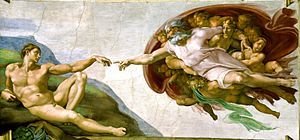
Pope Julius II asked Michelangelo to repaint the chapel's ceiling in 1508. Michelangelo finished this work between 1508 and 1512. Later, he painted The Last Judgment on the wall behind the altar, from 1535 to 1541, for Pope Paul III.
Michelangelo was a bit scared by how big the ceiling project was. He felt he was better at sculpting than painting. He even thought his enemies might have set him up for failure with such a huge painting job. For him, this project took him away from his main passion, which was carving marble sculptures.
The Ceiling Painting
To paint the high ceiling, Michelangelo needed a special scaffold. The first idea for a scaffold didn't work well. Michelangelo then designed his own platform. It was a flat wooden platform built from holes in the wall near the top of the windows. Contrary to popular belief, he didn't lie down to paint. He painted while standing up.
Michelangelo used very bright colors so the paintings could be easily seen from the floor below. On the lowest part of the ceiling, he painted the ancestors of Christ. Above them, he painted male and female prophets. On the highest part, Michelangelo painted nine stories from the Book of Genesis. These scenes show God's Creation, Adam and Eve in the Garden of Eden, and the Great Flood.
The painted area is about 40 meters (131 feet) long and 13 meters (43 feet) wide. This means Michelangelo painted over 5,000 square feet of frescoes!
The Last Judgement
Michelangelo painted The Last Judgement from 1535 to 1541. This huge painting covers the entire wall behind the altar. It shows the second coming of Christ on the Day of Judgment. At the top, Christ is shown as a powerful figure, surrounded by saints. On the bottom left, dead people rise from their graves to be judged. On the right, those who are sent to Hell are pulled down by demons.
The Last Judgement caused some arguments because Michelangelo painted naked figures. Some people thought this was wrong. An artist named Daniele da Volterra later painted clothes over some of the naked figures. He was even given the nickname "Il Braghettone," which means "the breeches-painter."
Replicas of the Chapel
There is a full-size copy of the Sistine Chapel in Mexico City. It was built by the Mexican Government and private donors. This replica uses 2.6 million high-definition photos to show all the frescoes and tapestries exactly as they are in the real chapel. Visitors can watch a video about the chapel's history before entering. Inside, a light and sound show explains the paintings.
Music in the Chapel
Since the chapel was built, the Sistine Chapel Choir has sung without musical instruments. Instruments were not allowed inside. To help the choir start singing at the right pitch, the oldest singer would choose the starting note.
In 2014, Canadian violinist Rosemary Siemens became the first solo musician to play an instrument in the Sistine Chapel. She performed with a singer and a harpist.
In 2016, The Edge from the band U2 became the first rock artist to perform a modern music concert in the chapel. He played U2 songs and a Leonard Cohen song.
In 2017, Cecilia Bartoli became the first woman to perform with the all-male Sistine Chapel Choir.
The first live-streamed concert from the chapel happened on April 22, 2018. The British Choir group The Sixteen performed a piece by Scottish composer James MacMillan. Over three hundred people attended, and it was streamed live online.
See also
 In Spanish: Capilla Sixtina para niños
In Spanish: Capilla Sixtina para niños


